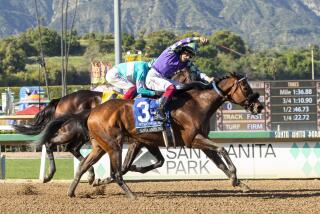It Takes a Fat Wallet to Make Money on Horses
- Share via
To experience the true adrenalin rush of thoroughbred ownership, the first thing you’re going to need is a horse.
First question: How much do you want to spend?
Find a competent bloodstock agent familiar with bloodlines and the horse market. Agents can be found through industry publications, through California Thoroughbred Sales Inc. (located in Arcadia), through acquaintances who own horses, or through trainers.
“People should make sure they can get a good agent who can relate the proper amount of money they want to spend to the proper product,” said Edward Bowen, editor of Blood Horse magazine.
Most people start out with fillies or mares--their ability to produce other horses is an outstanding feature.
The older the horse, the more expensive it is likely to be. Yearlings can sell for as little as $2,000 at auctions, but the median price for decent horses currently is closer to $20,000 to $60,000.
Naturally, horses that are older and have already raced--particularly those that are still young but have already shown potential on the track--will be more expensive. Many horses are purchased in claiming races, which are run almost every day at tracks. In a claiming race, a person can purchase (through a trainer) a horse that runs for a set price, maybe $20,000 to $35,000.
The chances of being successful dramatically increase by spending money for a good horse, the experts say. Buying a cheap horse is like “fielding an NFL team with a bunch of 20th-round draft choices,” syndicated handicapper and horse owner Jeff Siegel said.
There is insurance available on horse purchases. For example, it might cost 5% of the value of a horse to take out mortality insurance on a yearling. There are also insurance packages for horses purchased from claiming races and insurance for breeding (that a foal will actually be produced after the stud fee is paid).
Most owners consider insurance premiums too high, though.
Buying a yearling also means there will be at least a year of raising and training the horse before it ever sees a track. A horse in training may cost as much as $2,000 a month to keep sheltered, well-fed and trained. The horse must also be kept shod and a veterinarian will have to visit occasionally to make sure the horse is feeling well.
If the horse is fortunate enough to avoid disease and injury, and actually shows an ability to understand the concept of racing, it will cost to ship the horse to the track.
Once the horse is set up in a plush track stable, a trainer will cost $50 to $60 a day, plus 10% of the earnings. A jockey will earn 10% of any money the horse earns, or $35 to $75 a race, depending on the kind of race.
One piece of good news: It doesn’t cost anything to actually enter a race, unless it’s a big stakes race, in which case it may cost as much as $10,000.
Once on the track, the horse’s chances of injury increase. Or, just as bad, it may be discovered that the horse is simply slow, skittish or basically untalented.
“So many things can happen beyond your control,” Siegel said. “You can’t overemphasize the luck factor.”
More to Read
Go beyond the scoreboard
Get the latest on L.A.'s teams in the daily Sports Report newsletter.
You may occasionally receive promotional content from the Los Angeles Times.










